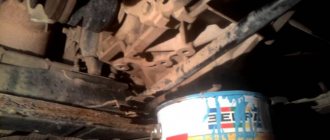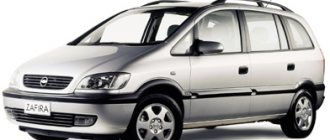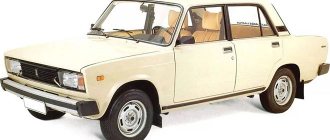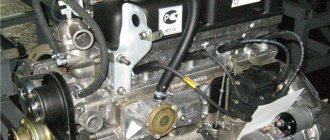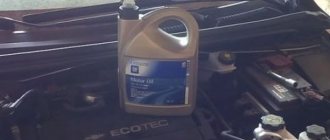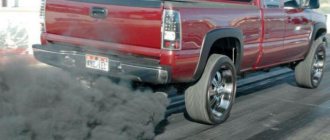- home
- Brands
- YaMZ
21.09.2020
YaMZ-236 is a widely used diesel engine that is used to equip trucks and special equipment. The motor has existed since the 1960s in various modifications and remains relevant thanks to numerous upgrades. With a working volume of 15 liters, its power ranges from 180 to 420 hp. With. According to data for 2014, the YaMZ-238 has given way to more modern YaMZ-656/658 engines, but is still produced in disassembled form, and its components are supplied for earlier produced cars: MAZ-500/503/504/509/516 ( 180 hp), MAZ-5335 (180-300 hp), Ural 4320 (230 hp), LiAZ-5256 (230 hp), MAZ-104 (230 hp) ) etc.
Regulations for changing oil in internal combustion engines
Experienced motorists and specialists recommend changing the oil in the YaMZ-236 engine every 10-15 thousand km. With used oil, if it is not changed for a long time, there is a high probability of engine failure and major repairs, but all this will be preceded by technical problems. Let's look at them in more detail:
- Used oil inevitably loses all its useful and protective components, the chemical composition of the oil degrades and overheating occurs.
- Old oil does not remove heat well, which leads to increased wear of internal combustion engine parts, which also lack high-quality lubrication. The parts end up melting.
- Fuel consumption increases, tapping noises, noises and other extraneous sounds appear.
- There are more and more wear products and dirt, it clogs the oil channels of the engine, and it fails.
Login to the site
One of the important factors in the operation of an internal combustion engine is the compression in its cylinders, which indicates the maximum pressure value when the internal combustion engine is idling. Individual engine models require different compression levels. WHAT IS ENGINE COMPRESSION? Among car owners, compression is considered a diagnostic factor that allows one to assess the performance of the car’s engine and the condition of the piston group. The compression indicator is the value of the pressure in the cylinders of a car, which the piston creates at its top point at the end of the compression stroke. The units for measuring engine compression are atmosphere, bar, kg/cm2 and MPa. High compression in the cylinders protects the crankcase from excessive gases, thus all gases are directed to perform useful work. At the same time, fuel and oil consumption is reduced, and accordingly, engine power and efficiency are increased. With low compression, the power of the internal combustion engine decreases, the dynamics of the vehicle deteriorate and fuel consumption increases. Not very experienced car owners sometimes confuse the concept of “compression” with the concept of “compression ratio”, but, in fact, these are different things. The compression ratio is the ratio of the volume of the engine cylinder to the volume of the combustion chamber. The compression ratio, unlike compression, is a constant value and is indicated by the manufacturer in the documentation. Compression changes its value over time due to the gradual wear of the components of the piston group and, as a result, a decrease in pressure in the cylinder. Compression in a car engine depends on the compression ratio; this relationship of values is displayed in calculated coefficients for each type of internal combustion engine. WHAT SHOULD BE THE COMPRESSION OF A PETROL ENGINE? Let's take a closer look at engine compression indicators for some car models. The standard formula for determining compression looks like this: Compression = compression ratio x coefficient X The compression ratio is indicated in the technical documents of the internal combustion engine, and each car model has its own compression ratio. The X coefficient is also determined separately for each group of engines, for example, 4-stroke gasoline engines with spark ignition have a coefficient of 1.2-1.3. For clarity, we will give an example of how compression is calculated in a VAZ engine, which is a 4-stroke engine, using this formula. The compression ratio of the VAZ 2112 car, indicated in the documents, is 10.5. Substituting the required values into the formula, we get the following: Compression in the VAZ 2112 engine = 10.5 x 1.2 = 12.6 Compression indicators in other VAZ car models, provided that all systems and assemblies are in working order: Car Compression, kg/cm2 VAZ 2106- 07 11 VAZ 2109 11 VAZ 2110 13 Compression in gasoline engines of some other car models from different manufacturers is shown in the table below. THE VALUE OF DIESEL ENGINE COMPRESSION The compression ratio in a diesel internal combustion engine is significantly higher than in gasoline engines, since the ignition of the combustible mixture in diesel engines occurs from compression by strong pressure, and not from a spark plug. The fuel is heated to its ignition temperature at a pressure of approximately 35 kg/cm2. Of course, the final pressure sufficient to ignite diesel fuel depends on certain conditions such as the ambient temperature or the condition of the engine itself. But the obvious conclusion can be drawn that as compression decreases due to piston wear, it becomes increasingly difficult to start a diesel car. Experts have calculated the compression value of a diesel engine sufficient to start it in conditions of different external temperatures: - 40 - the engine starts at temperatures down to -35; — 36 — the car will start at -30 degrees; — 32 — starts after a long stay at a temperature of -25; — 28 — the fuel will ignite after a long stay at -15; — 25 — The internal combustion engine starts without problems in a warm environment and after a long stay at -15; - 22-23 - an engine that has not cooled down starts immediately, long-term parking is possible only in the garage at above-zero temperatures; - less than 18 - even a heated internal combustion engine will not start under any conditions. The given gradation will be reliable when starting serviceable engines, in cars with all working systems. If there are malfunctions, the given indicators may not correspond to reality. The compression values in a diesel engine of some car models are given below: car compression Kamaz EURO-0 29-35 Kamaz EURO-1 29-35 Kamaz EURO-2 29-35 Kamaz EURO-3 32-37 Kamaz EURO-4 32-39 YaMZ 236 33-38 YaMZ 236 Turbo 33-38 YaMZ 238 33-38 YaMZ 238 Turbo 33-38 YaMZ 240 33-38 YaMZ 240 Turbo 33-38 D240-245(MTZ80-82) 24-32 MAN F90/2000 30-38 MEASUREMENT ENGINE COMPRESSION The compression indicator is greatly influenced by the technical condition of the engine and the conditions in which measurements are taken, so compression measurements are always carried out in the same mode, in the same way. Typically, measurements are carried out under the following conditions: - engine warmed up to operating temperature; — open throttle; — removed air filter; — turned out spark plugs in all cylinders; — low-voltage wires disconnected from the coils; — disconnected fuel hose; — charged battery; - a working starter. The compression measurement process itself is carried out using a compression meter and a spark plug wrench. The compression gauge is inserted into the hole from the unscrewed spark plug simultaneously with the engine starting at idle and held until the readings on the scale stop increasing. Such manipulations are carried out with all engine cylinders. The data obtained when measuring compression usually differs from the figures stated by the car manufacturer in the technical documentation. The discrepancy in values is explained by the wear of the piston group, which occurs during regular use of the vehicle. As wear of parts increases, compression in the engine cylinders decreases. Of course, with a slight deviation from the figures declared by the manufacturer, the car owner can continue to use it without repairing the piston group; a discrepancy of up to 10% is considered acceptable. As the gap in values increases, the components of the internal combustion engine are considered to be heavily worn. WHAT TO DO WHEN ENGINE COMPRESSION IS LOW? There comes a time in the life of many car owners when they are faced with problems of low engine compression. The pressure in the cylinders of an internal combustion engine may decrease for the following reasons: - piston rings stuck in the piston grooves - the most common reason for a decrease in compression; — a crack in the bridge of one of the pistons; — piston burnout; — deformation or burnout of the valve; - camshaft cam defect; — the appearance of carbon deposits due to wear of the valve stem seals. For the reasons listed above, compression usually decreases in one cylinder, and major engine overhaul is not required. In these cases, it is enough to replace parts and clean the combustion chamber from carbon deposits. If compression decreases simultaneously in all cylinders, the tightness of the combustion chamber is most likely broken and adjustment of the gaps and gas distribution mechanism (GRM) is required, which may entail a major overhaul of the engine. In diesel engines, the most common reason for a decrease in compression is wear of the cylinder bore. At the same time, the worn inner surface of the cylinder increases the gap between it and the piston, and it turns out that the pressure necessary to ignite the mixture of diesel fuel and air cannot be created. A sign of reduced compression in a diesel engine is the appearance of blue smoke from the exhaust pipe due to incomplete combustion of diesel fuel at an insufficiently high temperature. Sometimes malfunctions of third-party parts can lead to a decrease in pressure in the cylinders, for example, poor fuel atomization due to a faulty injector. In any case, timely replacement or repair of damaged parts and assemblies will eliminate the problems of low engine compression, and its power will increase again.
https://avtoshtuchki24.ru
Refueling tanks of units – Regulatory and technical documentation – About MAZ
Unit Lubrication system capacity, l Cooling system capacity, l Note YaMZ-236 HE2, BE2, YaMZ-7601.10 24.0 40 without PZD 42 with PZD YaMZ-7511.10 32.0 48 without PZD 50 with PZD YaMZ-238 DE2 32.0 47 without PZD 49 with PZD YaMZ-6581.10, 6582.10 Euro 3 32.0 48 without PZD 50 with PZD YaMZ-6561.10, YaMZ-6562.10, YaMZ-6563.10 Euro 3 24.0 41 without PZD 43 with PZD MMZ 245.30 E2 14 ,8 21.9 MMZ 260.5 E2 18.0 31.0 Gearbox YaMZ 239 11.5 Gearbox YaMZ-238M, 2381, ZF 9S109 8.0 Gearbox MAZ-543205 9.0 Gearbox YaMZ-236, 2361 5.5 Gearbox MZKT-65151 7.5 Gearbox ZF 16S151 11.0 Gearbox ZF 16S221 13.0 Gearbox ZF 14.5 Gearbox ZF S5-42 3.2 Gearbox ZF 6S850 7.5 Gearbox China 9JS135A, 9JS 150F, 9JS 180A 13.0 Gearbox China 12JS200TA 15 .5 SAAZ 3206.70, 695D gearbox 4.5 SAAZ 4334M2 gearbox 6.0 KamAZ-15.152 gearbox 12.0 KamAZ-14.142 gearbox 8.0
maz-auto.info
Yamz 238 filling containers
Main indicators of YaMZ-238 filling tanks:
- The volume of the lubrication system is 32 l.
- The volume of the cooling system, excluding the radiator volume, is 20 liters.
- The air filter has a volume of 1.4 liters.
- The volume of the high pressure fuel pump is 0.20 l.
- Regulator, volume 0.10 l.
An unfuelled engine weighs:
- 820-1010 kg, excluding auxiliary equipment;
- 880-1070 kg, including a set of auxiliary equipment;
- 1170-1385 kg including gearbox, clutch and accessories kit.
Engine filling capacity
- volume of the engine lubrication system: 24-32 liters, excluding the oil cooler;
- cooling system volume: 17-20 liters, excluding radiator;
- The air filter has a volume of 1.6-1.4 liters;
- fuel pump, volume 0.15-0.2 liters;
- Regulator volume: 0.15 liters;
- gearbox, volume 5.5 liters;
- the mechanism for remote control of the gearbox has a volume of 0.16 liters.
About the history of the creation of YaMZ-236 and its predecessors
YaMZ-236 has a solid and glorious history. It began at the turn of the 50s and 60s of the twentieth century, when the design bureau of the Yaroslavl Motor Plant was given the task: to develop and launch into series a modern and economical diesel engine with a “wide profile”, which could be used not only in cars and tractors, but also in many other areas of the national economy.
In the Soviet Union at that time, a course was taken towards the general “dieselization” of heavy vehicles. Most trucks then ran on gasoline and were very uneconomical in terms of fuel consumption. New, modern, highly efficient and economical “engines” running on diesel fuel were supposed to be equipped with heavy-duty vehicles and truck tractors; buses and tractors, various special equipment.
It should be noted that at that time the USSR was actually “ahead of the rest” in terms of the level of development of industrial technologies and engineering. For us, modern people, accustomed to our country lagging behind developed countries in technological terms, this is unusual. But at that time, the new engines, launched into production at the Yaroslavl plant in 1961, the YaMZ-236 and YaMZ-238 (eight-cylinder version) were truly the best in the world.
YaAZ-204 and YaAZ-206 are the “ancestors” of YaMZ-236 and YaMZ-238
These diesel engines became direct “descendants” of the YaAZ-204 and YaAZ-206 diesel engines, which were produced at the Yaroslavl (until 1958 it was called the “automobile”) engine plant. By the time the YaMZ-236 was developed, these two-stroke 4- and 6-cylinder engines were already quite outdated, both technically and morally. After all, they were created on the basis of General Motor’s diesel engines “GMS-4/71” and “GMS-6/71” of the 30s of the twentieth century.
When developing and launching mass production of new generation diesel engines, Soviet specialists relied on the rich experience in diesel production gained in the domestic industry. Remember: the Germans, British and Americans fought the entire Great Patriotic War on gasoline tanks. While in the USSR only pre-war BTs were petrol-powered. Both the legendary T-34 and all subsequent Soviet combat vehicles were diesel.
The group for the creation of new Yaroslavl diesel engines was led by the outstanding Soviet scientist, designer, inventor, Doctor of Technical Sciences Georgy Dmitrievich Chernyshev. With his direct participation, a family of YaMZ engines was created that met the requirements of the time, which became an excellent energy basis for the national economy of the USSR. The state received a powerful, reliable, extremely versatile diesel engine, which has simple maintenance, unpretentiousness and the ability to use cheap spare parts.
In the YaMZ assembly shop. Photo from 2014.
The new YaMZ-236 diesel engine turned out to be so efficient and reliable that it immediately became the only standard one for dozens of different types of equipment, and after more than half a century it continues to be produced at the Yaroslavl Motor Plant - in dozens of different modifications!
Although since then, of course, world technology has gone far ahead, and this motor is no longer the best in the world. In terms of performance and efficiency of use, it can be compared with modern Chinese analogues on the market. But in terms of reliability and maintainability, it is still ahead not only of the “Chinese”, but also of the world’s best analogues “originally” from the most developed countries.
Device
The design of this vehicle model includes:
- Engine, rear axle, air flow cooling system, brake system, gearbox, electrical equipment, body.
- Coupling mechanism. It consists of a pedal, a main cylindrical element, a working cylinder, a fork that disengages the coupling device, a pressure bearing, and pipelines.
- Crank mechanism. It is necessary to convert the translational motion from the piston part into the rotational motion of the crankshaft. Such a device includes a piston with rings, a piston pin, a flywheel, a block of cylindrical elements, a gasket, and a pan.
- Frame and towing device. The design of these mechanisms includes brackets, side members, cross member, fasteners, rear flange, spring mechanism and anti-roll bar.
Technical features of engines YaMZ-236, YaMZ-238
Of course, other technical characteristics also play a role in the effective operation of the motors under consideration, so it makes sense to dwell on them:
- type – diesel and turbodiesel (YaMZ 238e);
- number of cylinders. YaMZ 236 – 6-cylinder, YaMZ 238 – 8-cylinder;
- arrangement of cylinders. In YaMZ 236 – V-shaped, in YaMZ 238 – U-shaped;
- horsepower - from 180 to 240;
- fuel injection - direct type;
- cooling - due to special liquids;
- modification of models - atmospheric and turbocharged;
- mileage life – from 800 thousand km to 1,000,000 km.
All these points are very important to take into account.
YaMZ 238 photo selection
Contents: Tractor t 40 description and photos Tractor t 40 photo selection Engine of the tractor t 40 device and characteristics Repair of the engine of the tractor t 40 Front axle of the tractor t 40 device […]
Contents: PD 10 repair and installation of the starting engine Launcher PD-10: device Repair of the PD-10 starting engine PD-10 gearbox PD-10 carburetor. The design of the carburetor of the starting engine Cylinder PD-10 PD-10 engines: repair and installation […]
Diesel AM-01 is a six-cylinder water-cooled diesel engine with undivided combustion chambers. The diesel crankcase of a rigid design is equipped with wet type liners. The diesel engine has two heads, each with three […]
YaMZ-236 device
The cylinder block is cast from low-alloy, gray cast iron with wet liners (0.1 mm projection). The crankshaft stands on four supports inside the cylinder block.
- The piston stroke is 140 mm.
- Neck diameter – 110 mm.
- Crankpin – 88 m.
- Connecting rod length – 265 mm.
- Piston diameter – 130 mm.
- Piston height – 100 mm.
Two 6-valve cast iron cylinder heads are installed on the cylinder block. Inlet/exhaust valve - 61/48 mm, with a stem thickness of 12 mm. YaMZ-236 belongs to the lower engine type, so its camshaft is located in the cylinder block. Camshaft characteristics: phase 246/266, lift 13.5 mm.
The clearances of the intake and exhaust valves are 0.25-0.30 mm. Adjustment order: 1-4-2-5-3-6. It is recommended to carry out valve adjustment work every 500 operating hours.
- Boring of the seats of the main bearing shells is carried out together with their covers; therefore, the covers are marked for each shell separately.
- Cylinder liners are cast from special cast iron. They are sealed on top with a cylinder head gasket, and on the bottom with rubber rings.
- The crankshaft is made of steel and is manufactured by hot stamping. It has 3 crankpins and 4 main bearings.
- The cylinder head is cast from low-alloy gray cast iron, just like the cylinder block itself. The cooling system of the block head is a “jacket”, which is connected to the “jacket” of the main block. The cylinder head and the block are joined through a gasket.
- Timing mechanism is overhead valve with lower camshaft. The shaft is made of carbon steel with hardened bearings and cams and is located in the camber of the cylinder block.
- The valve seats are made of heat-resistant alloy and are pressed into their seats. Springs, timing valves, pushers and injectors are located in the cylinder head.
The oil pressure in a warm engine should be within 4-7 kgf/sq.cm.
The YaMZ-236 itself is a simple diesel engine with direct fuel injection. It has a lot of modifications and each of them contains different injectors, pumps, turbochargers, generators and other attachments.
How much oil to fill in YaMZ 238
Years of production – 1960-2014
The YaMZ-238 is based on a power supply system with a mechanical injection pump and direct fuel injection. The camber of the cylinder block contains the intake manifolds, and the OHV valve train is located in the head and is driven through rocker arms. The lower camshaft is mounted above the crankshaft and is driven through two gears located at the front end of the internal combustion engine. The rods are equipped with roller pushers. To ensure uniform flashes every 90 degrees, the crankpins of the crankshaft are located at the appropriate angle (90 degrees). YaMZ-238 has a liquid cooling system, as well as high-strength cast iron liners and spring inlet/exhaust valves. With a working volume of 15 liters, engine power can reach between 235-420 hp. With. depending on modification.
Also read: Engine oil for Nissan Sunny engine
Diesel engines 1960-2014
YaMZ-238, 15.0 l (235-330 hp), oil volume - 29 (atmospheric) and 32 (turbocharged) l, approval - API-CC; viscosity index – GOST 25371; kinematic viscosity – GOST 33
What oil should be used for the YaMZ 236 engine
Original
Diesel oil GOST 5304-54 is poured into the YaMZ 236 engine. Viscosity must comply with GOST 25371 and GOST 33.
Unoriginal
The YaMZ 236 engine is filled with M-10-G2K oil in the summer; and in summer you should use M-8-G2K.
The following types of motor oils are suitable for YaMZ-238:
- Lukoil M-10-G2 (and) M8-G2 (and) TU 0253-0777-00148636-96
- Norsi, UfaNeftekhim M-6z/10-V GOST 10541-78
- Slavol M-3042U (M-10-G2u);
- Slavol M-2042U (M-8G2u) TU U 13932946.015-96
- Lukoil Standard SAE 10W-30, AP SF/CC
Engine Specifications
| Production | "Avtodiesel" Yaroslavl Motor Plant |
| Engine make | 236 |
| Years of manufacture | 1962-present |
| Cylinder block material | cast iron |
| engine's type | diesel |
| Configuration | V-shaped |
| Number of cylinders | 6 |
| Valves per cylinder | 2 |
| Piston stroke, (mm) | 140 |
| Cylinder diameter, (mm) | 130 |
| Compression ratio | 16.5 |
| Engine capacity, (cc.cm.) | 11150 |
| Engine power, (hp/rpm) | 250/2000 |
| Max. torque, (Nm/rpm) | 1078/1100-1300 |
| Environmental standards | Euro 0 Euro 1 Euro 2 |
| Turbocharger | TKR 90 |
| Engine weight, (kg.) | 890 (YaMZ-236M2) 950 (turbo) |
| Average fuel consumption at a speed of 60 km/h, l/100 km (when installed on a URAL 4320 vehicle) | 35 |
| Oil consumption, % of fuel consumption, up to | 0.5 0.2 (Euro 2) |
| Recommended engine oil: – for summer – for winter (at temperatures less than +5° C) | M-10-G2k M-8-G2k |
| Volume of engine oil in the engine, (l.) | 21 (atmospheric) 24 (turbocharged) |
| Oil change frequency, (motor hours) | 500 1000 (Euro-2) |
| Overall dimensions, (mm): - length - width - height | (YaMZ-236B) 1276 1045 1100 |
| Engine life - declared by the factory - in practice (on average) | 8000+ engine hours 800 t.km. |
| Applicability of YaMZ-236 | Download table |
How often to change the oil in YaMZ 236
The first types of motor (Euro-0/1) require updating the formula every 500 hours of operation. For the Euro-2 modification, the service interval increases to 1000 hours. The hours of use regulations are used due to the specificity of the model. In 70% of cases, the engine is installed on tractors, combines or specialized equipment, where calculation in kilometers is not relevant.
When using a car, replacement every 7-9 thousand kilometers is considered relevant. Under harsh operating conditions, the service interval is reduced to 6500-7000 km.
Fine oil filter - YaMZ-236, -238, -238NB:
201499-P29 236-1017010-A 236-1017020 236-1017031-B 236-1017122 236-1017162 236-1017180 236-1017224 236-1017250-B2 250615-P2 9 252136-P2 311808-P2 312103-P29 312310-P34 312497- P2 312672-P 8103
List of components for fine oil filter for YaMZ-236, -238, -238NB
Parts diagrams are for reference purposes only! We do not sell all spare parts from Fine oil filter for YaMZ-236, -238, -238NB presented in this list. If there is a “Show prices” link in the right column, these spare parts from “Fine oil filter” are on sale. Availability in warehouses for details and prices, see the product card. If there is no “Show cost” link in the right column, we do not sell such parts and do not accept orders for them.
| № | Part code | Name | Quantity per model, pcs. | Show all prices |
| 201499-P29 | Bolt 10-6gх30 | 3 | Show prices | |
| Quick view | Article: 201499-P29 In stock (555) Order code: 00002865 |
| Article: 252136-P2 In stock (208) Order code: 00006018 |
Recommended motor oils (YaMZ) - PSM
Recommended viscosity classes of motor oils for operation according to GOST 17479.1-85 depending on the ambient temperature, °C
Note: viscosity grades of oils SAE-SAEj 300 are given in parentheses
Oils for engines without turbocharging (YAMZ-1-97 oil group)
(YaMZ-236M2, YaMZ-238M2)
Oil brand Standard number Manufacturer
| M-10-G2(k) M-8-G2(k) | GOST 8581-78 | LLC LUKoil-Permnefteorgsintez, OJSC Norsi, OJSC Ryazan Refinery, OJSC Slavneft-Yaroslavnefteorgsintez, OJSC Yaroslavl Refinery named after. Mendeleev", LLC "LUKoil-Volgogradneftepererabotka", OJSC "Angarsk Petrochemical LUKoil-Permnefteorgsintez" |
| M-6z/10-V | GOST 10541-78 | OJSC Norsi, OJSC UfaNeftekhim |
| M-6z/12-G | TU 0253-011-00151742-95 | JSC "Kremenchug Oil Refinery" |
| Slavol M-3042U (M-10-G2u) Slavol M-2042U (M-8-G2u) | TU U 13932946.015-96 | NPP "Additives" |
| Lukoil Standard SAE 10W-30, AR SF/CC | TU 0253-072-00148636-95 amended. 1-8 | LLC "LUKoil-Permnefteorgsintez" |
Note:
For engines without turbocharging, it is allowed to use oils of the YaMZ-2-97 - YaMZ-5-06 groups with a twice as long change period.
Oils for forced turbocharged engines (Oil group YaMZ-2-97 ~ YaMZ-3-02)
(YaMZ-236B, YaMZ-238D, YaMZ-850.10)
Oil brand Standard number Manufacturer
| M-10-D2(m) M-8-D2(m) | GOST 8581-78 | LLC LUKoil-Permnefteorgsintez, OJSC Slavneft-Yaroslavnefteorgsintez, JSC Azmol, Berdyansk OJSC Angarsk Petrochemical Ryazan Refinery, LLC LUKoil-Volgogradneftepererabotka |
| Consol M-10-D2(m) Consol M-8-D2(m) | GOST 8581-78 | VIAL OIL LLC, Moscow |
| Omskoil-Turbo 2 (M-10-D2(m)) | TU 38.301-19-110-97 amended. 1-4 | OJSC Omsk Oil Refinery |
| Sam-Oil-4126 M-10-D2(m) | TU 38.301-13-008-97 | OJSC "Novokuibyshevsky Oil Refinery" |
| Sam-Oil-4127 M-6z/14-D(m) | TU 38.301-13-008-97 | OJSC "Novokuibyshevsky Oil Refinery" |
| LUKoil-Super (SAE 15W-40, API CF-4/SG) M-5z/14-E | TU 0253-075-00148636-99 amended. 1 | LLC "NORSI", Kstovo |
| LUKoil-Super (SAE 15W-40, API CD/SF) M-5z/14D(m) | TU 0253-004-00148599-00 as amended. 1 | LLC "LUKoil-Volgogradneftepererabotka" |
| M-16-DR | TU 38.401.642-87 | OJSC Rosneft-MOPZ Nefteprodukt |
| Castrol Formula RS Rasing Syntec (SAE 20W-60, API SH/CF) | — | |
| Titan GT (SAE 20W-50, API SG/CD) | — | |
| Titan Supersyn SL (SAE 5W-50, API CF/SI) | — |
Note: For turbocharged engines, the use of oils of the YaMZ-4-02, YaMZ-5-06 groups is allowed.
Oils for turbocharged engines that meet Euro-2 environmental standards (YAMZ-4-02 oil group)
(YaMZ-7511.10)
Oil brand Standard number Manufacturer
| UTEC Superdiesel (SAE 10W-40, API CF-4/SG) M-4z/14-E UTEC Superdiesel (SAE 15W-40, API CF-4/SG) M-5z/14-E | TU 0253-283-05742746-95 amended. 1 | OJSC "Angarsk Petrochemical LUKoil-Permnefteorgsintez" |
| Rolls Turbo (SAE 15W-40, API CF-4/SF) M-5z/14-E | TU 38.301-41-185-99 | OJSC "Ryazan Oil Refinery" |
| LUKOIL-avant-garde (SAE 15W-40, API СG-4/SJ) М-5з/14-Э | TU 0253-102-00148636-00 as amended. 1…4 | LLC "LUKoil-Permnefteorgsintez" |
| Spectrol Champion (SAE 15W-40, API CF-4/SG) M-5z/14-E | TU 0253-15-06913380-98 | CJSC PG "Spektr-Avto" Moscow |
| Essolube XT-4 (SAE 15W-40, API CF-4/CF) | — | Exxon Mobil Company |
| Consol Titan Transit (SAE 15W-40, API CF-4/SG) M-5z/14-E | TU 0253-007-17280618-2000 | VIAL OIL LLC, Moscow |
| Shell Rimula D (SAE 10W-30, API CF-4/SG) | — | Shell East Europe Co |
| Shell Rimula D (SAE 15W-40, API CF-4/SG) | — | Shell East Europe Co |
| VNII NP M-5z/16-D2 | TU 38.401-58-309-2002 | OJSC Rosneft MOPZ Nefteprodukt |
| Ravenol Turbo-Plus SHPD (SAE 15W-40, API CI-4/CH-4/CF/SL) | — | Ravensberger Schmierstoffvertrieb GmbH, Germany |
| LUKOIL-Diesel (SAE 10W-40, API CF-4/SG) M-5z/14-E | TU 38.601-07-38-2002 | OJSC LUKoil-Nizhegorodnefteorgsintez |
Note: For YaMZ engines that meet Euro-2 environmental standards, the use of motor oils of the following groups is allowed: a) YaMZ-5-06, b) YaMZ-2-97...YaMZ-3-02 with a change period half as long as for group oils YaMZ-4-02.
Approximate correspondence between the level of performance properties of oils according to different classifications*
Designation of oils according to RD 37.319.034-97 OJSC Avtodizel Approximate compliance with STO AAI 003-98 GOST 17479.1-85 API
| YaMZ-1-97 | D1 | G2 | CC |
| YaMZ-2-97 | D 2 | D | CD |
| YaMZ-3-02 | D3 | E | CF-4 |
| YaMZ-4-02 | CG-4 |
Note: STO AAI 003-98 – Standard of the Association of Automotive Engineers of the Russian Federation “Motor oils for automobile engines. Classification, designation and technical requirements." * GOST 17479.1-85 – Standard “Motor oils. Classification and designation." * API – American Petroleum Institute. www.powerunit.ru
